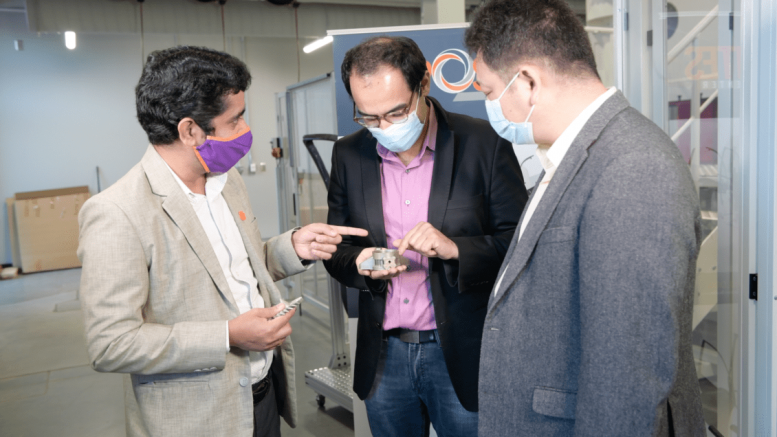Research will leverage 3D Systems’ direct metal printing, advanced plastics and composites technology
Clemson University researchers are receiving funding from the U.S. Army Combat Capabilities Development Command, known as DEVCOM, Army Research Laboratory (ARL) to create new technology aimed at helping speed up development of new 3D-printed components for future ground vehicles, air platforms and munitions.
Researchers said that they will create a “digital lifecycle platform” augmented with artificial intelligence as part of the project. The idea behind the platform is to help production engineers more quickly and inexpensively design, analyze and fabricate a wide range of large and complex geometry components with embedded multi-functionalities, such as ground and air vehicle structures with power transmission, energy storage, sensing and self-monitoring functions, for achieving overall size, weight, power and cost (SWaP-C) efficiencies.
Once fully developed, the platform would allow engineers to design and test new components without physically building them.
An $11 million cooperative agreement was established with DEVCOM ARL. First-phase funding equals $6.3 million, which supports and advances the research enterprise at the Clemson Composites Center.
“This agreement is another example of Clemson’s growing emphasis on partnering with industry and the government to leverage the university’s research expertise to benefit our state and nation,” said Clemson President Jim Clements. “I am very proud of the work being done by our faculty that will allow this cutting-edge technology to play an important role in the creation of next-generation vehicles and other vital equipment for our military.”
The research is based at the new Clemson Composites Center at the Greenville Technical College’s Center for Manufacturing Innovation, adjacent to the Clemson University International Center for Automotive Research (CU-ICAR). 3D Systems (NYSE:DDD) of Rock Hill, South Carolina is collaborating in bringing to bear technologies and capabilities that are part of the unique 9-laser, 1m x 1m x 600mm metal 3D printer being created for DEVCOM ARL.
“Over the past few years South Carolina has seen record investment and growth, a large portion of which can be accredited to the willingness of our colleges and universities to partner with new and existing businesses,” said Gov. Henry McMaster. “This project between Clemson and 3D Systems highlights the success and the continued commitment of our higher education system to not only provide a highly skilled workforce but to forge important partnerships with our business community that ultimately lead to a stronger South Carolina.”
Daniel L. Noneaker, associate dean for research in Clemson’s College of Engineering, Computing and Applied Sciences, said the project will help advance the field of 3D printing, also called additive manufacturing.
“Clemson has assembled an interdisciplinary team of top talent and partnered with 3D Systems, a world-class company,” he said. “All the pieces are in place for transformative, translational research. I thank the U.S. Army Research Laboratory for providing the funding that will make this project possible.”
Clemson faculty involved in the project include: Fadi Abdeljawad, assistant professor of mechanical engineering; Gang Li, a professor of mechanical engineering and associate director of the Clemson Composites Center; Shunyu Liu, assistant professor of automotive engineering; and Rahul Rai, Dean’s Distinguished Professor of automotive engineering.

Srikanth Pilla
Several postdoctoral researchers, graduate students and undergraduates will participate in the research, providing them with experience on the cutting-edge of 3D printing technology. The principal investigator on the project is Srikanth Pilla, the Robert Patrick Jenkins Endowed Professor within the College of Engineering, Computing and Applied Sciences and founding director of the Clemson Composites Center.
Part of the challenge in 3D-printing new components is using the right feedstock – the material fed into the 3D printer to print the component. Researchers need to understand the combination of materials and what amounts will create the desired properties, such as strength or stiffness.
“As part of the new project, we will develop a database of raw materials, including metals, plastics and composite materials, that could then be used to train artificial intelligence and create digital models of potential new feedstock materials,” Pilla said.
To create the database, the researchers plan to print samples called coupons and subject them to a series of tests to measure their chemical, mechanical and thermophysical properties.
Researchers said the coupon testing will position them for more advanced studies in the future. In those studies, they would 3D-print subcomponents that take into account the complex geometries of full-size components.
“The database development as well as validation of the digital life cycle through experimental characterization and testing are enabled using the state-of-the-art infrastructure available at the Clemson Composites Center which includes 3D printers, thermophysical testing equipment, optical metrology, quasi-static and dynamic drop-tower test infrastructure, accelerated aging equipment, high-speed cameras and spectroscopic equipment,” Pilla said.
Clemson is excited to pursue another collaborative opportunity with ARL called the MX Initiative, Pilla said. The project brings together a multidisciplinary team of Clemson faculty members from materials science, mechanical engineering, civil engineering, chemical engineering, computer science and the Clemson Composites Center, to conduct fundamental and applied research in support of U.S. Army modernization and future capabilities.
Jose Doval, advanced R&D director at 3D Systems, said he looks forward to collaborating with the team to further expand the applications addressed with the company’s advanced metal 3D printing technologies.
“3D Systems was founded on a spirit of innovation, and our customers’ unique applications fuel our efforts to create new technologies,” Doval said. “Through our collaboration with the U.S. Army Research Laboratory, we’ve made tremendous strides in developing the world’s largest, fastest metal powder 3D printer. Expanding this work with Clemson University allows us to push the limits of the technology even further. This includes investigating new methods of in-situ detection, as well as ways to visualize the build in real-time from the data collected in each layer.”
Stephanie Koch, associate director for DEVCOM ARL’s Weapons and Materials Research Directorate, said, “This collaboration will advance the laboratory’s ability to find new and novel ways to advance the science of advanced manufacturing as well as creating a pipeline of new talent, all towards our mission to operationalize science for transformational overmatch.”
Clemson officials said they expected the project to significantly boost the University’s expertise in additive manufacturing.
“We’ll be helping create next-generation technology, and having all that knowledge and infrastructure at Clemson will be a tremendous benefit to South Carolina,” said Zoran Filipi, chair of the Department of Automotive Engineering. “More and more manufacturers are using additive manufacturing. We’ll be well positioned to help take the technology to the next level.”
Atul Kelkar, chair of Clemson’s Department of Mechanical Engineering, said the project will help build the next generation of additive manufacturing talent.
“This project will give our students the opportunity to not only work on but also create the latest technology with 3D Systems, a global leader in the industry,” he said. “They will be well prepared to hit the ground running when they enter the workforce or expand their research if they choose to stay in academia.”
Anand Gramopadhye, dean of the College of Engineering, Computing and Applied Sciences, said the project will enable impactful work.
“I congratulate the team on securing this grant,” he said. “The amount of the award is a testament to the level of talent on the team and the potential for innovation in additive manufacturing. Clemson is well positioned to lead the state’s academic research in this growing field.”


Be the first to comment on "Clemson University researchers to help advance 3D printing in partnership with U.S. Army Research Laboratory"